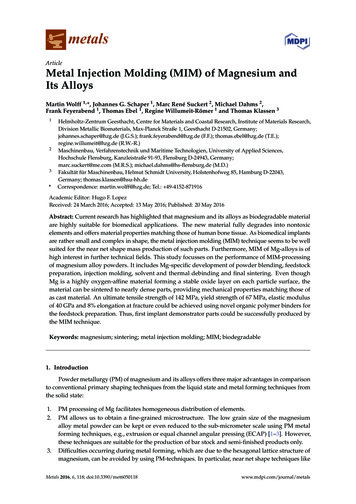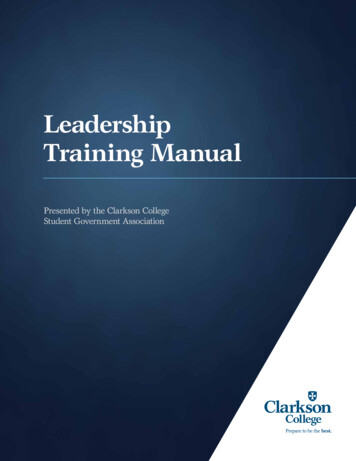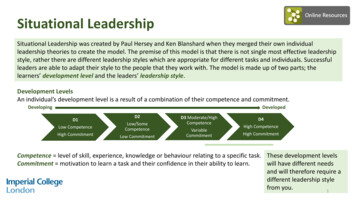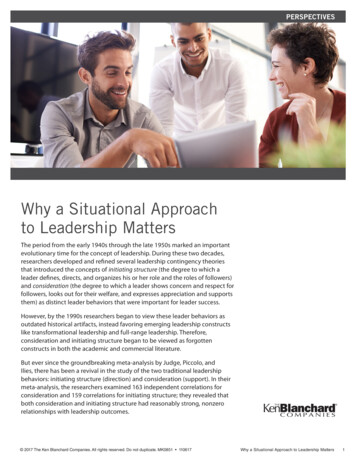
Transcription
Leadership inOrganizations
This page intentionally left blank
Eighth EditionLeadership inOrganizationsGary YuklUniversity of AlbanyState University of New YorkBoston Columbus Indianapolis New York San FranciscoUpper Saddle River Amsterdam Cape Town Dubai LondonMadrid Milan Munich Paris Montreal Toronto Delhi Mexico CitySao Paulo Sydney Hong Kong Seoul Singapore Taipei Tokyo
Editorial Director: Sally YaganAcquisitions Editor: Brian MickelsonDirector of Editorial Services: Ashley SantoraEditorial Project Manager: Sarah HolleDirector of Marketing: Maggie MoylanSenior Marketing Manager: Nikki JonesMarketing Assistant: Ian GoldProduction Project Manager: Renata ButeraCreative Art Director: Jayne ConteCover Designer: Suzanne BehnkeCover Art: Stephen Starthdee/IstockphotoFull-Service Project Management/Composition:Vijayakumar Sekar/Jouve IndiaPrinter/Binder: Courier/WestfordCover Printer: Lehigh-Phoenix Color/HagerstownText Font: 10/12 MinionCredits and acknowledgments borrowed from other sources and reproduced, with permission, in this textbookappear on the appropriate page within text.Copyright 2013, 2010, 2006, 2002, 1998 by Pearson Education, Inc., publishing as Prentice Hall. All rightsreserved. Manufactured in the United States of America. This publication is protected by Copyright, andpermission should be obtained from the publisher prior to any prohibited reproduction, storage in a retrievalsystem, or transmission in any form or by any means, electronic, mechanical, photocopying, recording, orlikewise. To obtain permission(s) to use material from this work, please submit a written request to PearsonEducation, Inc., Permissions Department, One Lake Street, Upper Saddle River, New Jersey 07458, or you may faxyour request to 201-236-3290.Many of the designations by manufacturers and sellers to distinguish their products are claimed as trademarks.Where those designations appear in this book, and the publisher was aware of a trademark claim, the designationshave been printed in initial caps or all caps.Library of Congress Cataloging-in-Publication DataYukl, Gary A.Leadership in organizations / Gary Yukl. — 8th ed.p. cm.Includes bibliographical references and index.ISBN 978-0-13-277186-31. Leadership. 2. Decision making. 3. Organization. I. Title.HD57.7.Y85 2013303.3'4—dc23201104680110 9 8 7 6 5 4 3 2 1ISBN 10: 0-13-277186-1ISBN 13: 978-0-13-277186-3
For her love and support this book is dedicated to Maureen.
This page intentionally left blank
BRIEF CONTENTSPreface xvChapter 1Chapter 2Chapter 3Chapter 4Chapter 5Chapter 6Chapter 7Chapter 8Chapter 9Chapter 10Chapter 11Chapter 12Chapter 13Chapter 14Chapter 15Chapter 16Introduction: The Nature of Leadership 1Nature of Managerial Work 23Effective Leadership Behavior 48Leading Change and Innovation 76Participative Leadership and Empowerment 105Leadership Traits and Skills 135Contingency Theories and Adaptive Leadership 162Power and Influence Tactics 185Dyadic Relations and Followers 221Leadership in Teams and Decision Groups 247Strategic Leadership in Organizations 276Charismatic and Transformational Leadership 309Ethical, Servant, Spiritual, and Authentic Leadership 340Cross-cultural Leadership and Diversity 360Developing Leadership Skills 381Overview and Integration 404References 424Author Index 483Subject Index 499vii
This page intentionally left blank
TABLE OF CONTENTSPrefacexvChapter 1 INTRODUCTION: THE NATURE OF LEADERSHIP 1Definitions of Leadership 2Indicators of Leadership Effectiveness 8Major Perspectives in Leadership Theory and Research 10Level of Conceptualization for Leadership Theories 14Other Bases for Comparing Leadership Theories 18Organization of the Book 20Summary 20Review and Discussion Questions 21Chapter 2 NATURE OF MANAGERIAL WORK 23Activity Patterns for Managers 24Decision Making and Planning by Managers 26Managerial Roles 29Demands, Constraints, and Choices 31Other Determinants of Managerial Work 34Limitations of the Descriptive Research 39Guidelines for Managers 40Summary 44Review and Discussion Questions 45CASE: Acme Manufacturing Company 45CHAPTER 3 EFFECTIVE LEADERSHIP BEHAVIOR 48Ways for Describing Leadership Behavior 48Major Types of Leadership Behavior 50Methods for Studying the Effects of Leader Behavior 53Effects of Task and Relations Behaviors 56Planning Work Activities 58Clarifying Roles and Objectives 59Monitoring Operations and Performance 61Supportive Leadership 63Developing Subordinate Skills 65ix
xTable of ContentsProviding Praise and Recognition 68Summary 71Review and Discussion Questions 72CASE: Consolidated Products 73CASE: Air Force Supply Squadron 74CHAPTER 4 LEADING CHANGE AND INNOVATION76Types of Change in Teams and Organizations 77Change Processes 78Reasons for Accepting or Rejecting Change 80Implementing Change 81Guidelines for Implementing Change 84How Visions Influence Change 89Collective Learning and Innovation 94Guidelines for Enhancing Learning and Innovation 98Summary 101Review and Discussion Questions 102CASE: Ultimate Office Products 102CHAPTER 5 PARTICIPATIVE LEADERSHIP AND EMPOWERMENT 105Nature of Participative Leadership 106Research on Effects of Participative Leadership 109Normative Decision Model 111Guidelines for Participative Leadership 115Delegation 118Guidelines for Delegating 122Perceived Empowerment 126Empowerment Programs 128Summary 130Review and Discussion Questions 131CASE: Echo Electronics 132CASE: Alvis Corporation 133CHAPTER 6 LEADERSHIP TRAITS AND SKILLS 135Introduction to the Trait Approach 135Personality Traits and Effective Leadership 138
Table of ContentsSkills and Effective Leadership 148Managerial Competencies 151Situational Relevance of Skills 153Evaluation of the Trait Approach 156Guidelines for Managers 157Summary 159Review and Discussion Questions 159CASE: National Products 160CHAPTER 7 CONTINGENCY THEORIES AND ADAPTIVELEADERSHIP 162General Description of Contingency Theories 163Early Contingency Theories 164Multiple-linkage Model 167Conceptual Weaknesses in Contingency Theories 173Research on Contingency Theories 174Comparative Evaluation of Contingency Theories 175Guidelines for Adaptive Leadership 177Guidelines for Managing Immediate Crises 179Summary 180Review and Discussion Questions 181CASE: Foreign Auto Shop 182CHAPTER 8 POWER AND INFLUENCE TACTICS 185Power and Influence Concepts 185Power Sources 188How Power Is Gained or Lost 193Consequences of Power 195Guidelines for Using Power 197Proactive Influence Tactics 201Effectiveness of Proactive Tactics 206Guidelines for Specific Tactics 210Power and Influence Behavior 215Summary 216Review and Discussion Questions 217CASE: Restview Hospital 218CASE: Sporting Goods Store 219xi
xiiTable of ContentsCHAPTER 9 DYADIC RELATIONS AND FOLLOWERS 221Leader-Member Exchange Theory 222Leader Attributions About Subordinates 225Leader Influence on Follower Emotions 227Guidelines for Correcting Performance Deficiencies 227Follower Attributions and Implicit Theories 231Impression Management by Leaders and Followers 234Follower Contributions to Effective Leadership 236Self-Management 237Guidelines for Followers 239Summary 243Review and Discussion Questions 243CASE: Cromwell Electronics 244CASE: American Financial Corporation 245CHAPTER 10 LEADERSHIP IN TEAMS AND DECISIONGROUPS 247Determinants of Team Performance 248Functional Work Teams 254Cross-functional Teams 255Self-managed Work Teams 258Virtual Teams 261Guidelines for Leading Teams 262Leading Decision Groups 265Guidelines for Leading Meetings 268Summary 272Review and Discussion Questions 273CASE: Southwest Engineering Services 273CHAPTER 11 STRATEGIC LEADERSHIP IN ORGANIZATIONS 276Determinants of Organizational Performance 277How Leaders Influence Organizational Performance 281Situations Affecting Strategic Leadership 284Organizational Culture 286Research on Effects of Strategic Leadership 289
Table of ContentsExecutive Teams 291Emerging Conceptions of Organizational Leadership 294Two Key Responsibilities for Top Executives 297Guidelines for Strategic Leadership 299Summary 302Review and Discussion Questions 303CASE: Costco 303CASE: Turnaround at Nissan 306CHAPTER 12 CHARISMATIC AND TRANSFORMATIONALLEADERSHIP 309Attribution Theory of Charismatic Leadership 310Self-Concept Theory of Charismatic Leadership 312Other Conceptions of Charisma 314Consequences of Charismatic Leadership 317Transformational Leadership 321Research on Charismatic and TransformationalLeadership 324Comparison of Charismatic and Transformational Leadership 328Evaluation of the Theories 330Guidelines for Inspirational Leadership 332Summary 335Review and Discussion Questions 336CASE: Astro Airlines 336CHAPTER 13 ETHICAL, SERVANT, SPIRITUAL, AND AUTHENTICLEADERSHIP 340Conceptions of Ethical Leadership 341Dilemmas in Assessing Ethical Leadership 342Determinants and Consequences of Ethical Leadership 344Theories of Ethical Leadership 347Evaluation of Ethical Leadership Theories 352Guidelines for Ethical Leadership 354Summary 357Review and Discussion Questions 358CASE: Unethical Leadership at Enron 358xiii
xivTable of ContentsCHAPTER 14 CROSS-CULTURAL LEADERSHIP AND DIVERSITY 360Introduction to Cross-cultural Leadership 361Cultural Value Dimensions and Leadership 365Evaluation of Cross-cultural Research 368Gender and Leadership 370Managing Diversity 376Summary 378Review and Discussion Questions 379CASE: Madison, Jones, and Conklin 379CHAPTER 15 DEVELOPING LEADERSHIP SKILLS 381Leadership Training Programs 382Learning from Experience 384Developmental Activities 385Facilitating Conditions for Leadership Development 396Systems Perspective on Leadership Development 398Summary 401Review and Discussion Questions 402CASE: Federated Industries 402CHAPTER 16 OVERVIEW AND INTEGRATION 404Major Findings About Effective Leadership 404Multilevel Explanatory Processes 408Toward an Integrating Conceptual Framework 415Limitations in Leadership Research 417Concluding Thoughts 421Review and Discussion Questions 423References 424Author Index 483Subject Index 499
PREFACEThis book is about leadership in organizations. Its primary focus is on managerial leadership asopposed to parliamentary leadership, leadership of social movements, or emergent leadership ininformal groups. The book presents a broad survey of theory and research on leadership in formal organizations. Topics of special interest are the determinants of leadership effectiveness andhow leadership can be improved.In this 8th edition, the following improvements were made to make the book easier to understand and more useful to most readers: Most chapters were revised for clarity and understanding (including Chapters 2, 3, 4, 6, 7,9, 10, 12, 15, and 16). The order of Chapters 4 to 12 was modified to improve explanation of related topics. Several new examples of effective and ineffective leadership were added to Chapters 4, 6,11, 13, and 14. More practical guidelines for effective leadership were added to Chapters 3, 6, 7, and 8. Several new examples were used in Chapters 3, 11, 12, and 14 to explain how research isconducted. Over 100 citations to recent research were added throughout.The basic structure of most chapters remains the same, but the order of some chapters waschanged and a few topics were moved to a different chapter. Citations to relevant recent literaturewere updated, but given the increasing volume of studies on leadership, the citations are still selective rather than comprehensive. Since the book is not intended to be a history of leadership, itseemed appropriate to reduce the amount of detail about early research programs and old theoriesthat are no longer popular, and focus more closely on what we now know about effective leadership.The content of the book still reflects a dual concern for theory and practice. I have attemptedto satisfy two different audiences with somewhat different preferences. Most academics prefer abook that explains and evaluates major theories and relevant empirical research. They are moreinterested in how well the research was done, what was found, and what additional research isneeded than in the practical applications. Academics tend to be skeptical about the value of prescriptions and guidelines for practitioners and consider them premature in the absence of furtherresearch. In contrast, most practitioners want some immediate answers about what to do and howto do it in order to be more effective as leaders. They need to deal with the current challenges oftheir job and cannot wait for decades until the academics resolve their theoretical disputes and obtain definitive answers. Practitioners are more interested in finding helpful remedies and prescriptions than in finding out how this knowledge was discovered. Readers who desire to improve theirleadership effectiveness will find this edition of the book is even more useful than previous editions.These different preferences are a one of the reasons for the much-lamented gulf betweenscientists and practitioners in management and industrial-organizational psychology. I believe itis important for managers and administrators to understand the complexity of effective leadership, the source of our knowledge about leadership in organizations, and the limitations ofthis knowledge. Likewise, I believe it is important for academics to think more about how theirtheories and research can be used to improve the practice of management. Too much of ourleadership research is designed to examine narrow, esoteric questions that only interest a fewother scholars who publish in the same journals.xv
xviPrefaceAcademics will be pleased to find that major theories are explained and evaluated, findingsin empirical research on leadership are summarized, and many references are provided to helpreaders find sources of additional information about topics of special interest. The field of leadership is still in a state of ferment, with many continuing controversies about conceptual andmethodological issues. The book addresses these issues whenever feasible. However, the literature review was intended to be incisive, not comprehensive. Rather than detailing an endlessseries of studies like most handbooks of leadership, the book describes major findings about effective leadership. The current edition reflects significant progress in our understanding of leadership since the first edition was published in 1981.For practitioners and students who desire to become effective managers, I attempted toconvey a better appreciation of the complexity of managerial leadership, the importance of having theoretical knowledge about leadership, and the need to be flexible and pragmatic in applyingthis knowledge. The current edition provides many guidelines and recommendations for improving managerial effectiveness, but it is not a “practitioner’s manual” of simple techniques andsecret recipes that guarantee instant success. The purpose of the guidelines is to help the readerunderstand the practical implications of the leadership theory and research, not to prescribe exactly how things must be done by a leader. Most of the guidelines are based on a limited amountof research and they are not infallible or relevant for all situations. Being a flexible, adaptiveleader includes determining which guidelines are relevent for each unique situation.Most chapters have one or two short cases designed to help the reader gain a better understanding of the theories, concepts, and guidelines presented in the chapter. The cases describeevents that occurred in real organizations, but some of the cases were modified to make themmore useful for learning basic concepts and effective practices. For most of the cases, the namesof organizations and individuals were changed to keep the analysis focused on the events that occurred in a defined time period, not on recent events that may involve different leaders and a newcontext. The cases ask a reader to analyze behavioral processes, identify examples of effectiveand ineffective behavior, and suggest effective ways to handle the situation that is depicted.An instructor’s manual is available with detailed analyses of the cases and suggestions onhow to use them. The instructor’s manual also includes additional cases, exercises for use in class(e.g., role plays), and some out-of-class activities that help students to understand how they canapply the theory and guidelines. Finally, a test bank is available with multiple-choice items on themajor points in each chapter.The book is widely used in many different countries, and some editions have been translatedinto other languages, including Chinese, Korean, Indonesian, Spanish, Greek, Croatian, andSwedish. With its focus on effective leadership in organizations, the book is especially relevant forpeople who expect to become a manager or administrator in the near future, for people who will beresponsible for training or coaching leaders, and for people who will be teaching courses or workshops that include leadership as one of the key topics. The book is appropriate for use as the primarytext in an undergraduate or graduate course in leadership. Such courses are found in many differentschools or departments, including business, psychology, sociology, educational administration, publicadministration, and health care administration. The book is on the list of required or recommendedreadings for students in many doctoral programs in leadership, management, and industrialorganizational psychology. Finally, the book is also useful for practicing managers and consultantswho are looking for something more than superficial answers to difficult questions about leadership.Gary YuklAlbany, New YorkJune, 2011
Chapter 1Introduction: The Natureof LeadershipLearning ObjectivesAfter studying this chapter, you should be able to: Understand the different ways leadership has been defined.Understand the controversy about differences between leadership and management.Understand why it is so difficult to assess leadership effectiveness.Understand the different indicators used to assess leadership effectiveness.Understand what aspects of leadership have been studied the most during the past 50 years.Understand the organization of this book.Leadership is a subject that has long excited interest among people. The term connotes imagesof powerful, dynamic individuals who command victorious armies, direct corporate empiresfrom atop gleaming skyscrapers, or shape the course of nations. The exploits of brave and cleverleaders are the essence of many legends and myths. Much of our description of history is thestory of military, political, religious, and social leaders who are credited or blamed for importanthistorical events, even though we do not understand very well how the events were caused orhow much influence the leader really had. The widespread fascination with leadership maybe because it is such a mysterious process, as well as one that touches everyone’s life. Why didcertain leaders (e.g., Gandhi, Mohammed, Mao Tse-tung) inspire such intense fervor and dedication? How did certain leaders (e.g., Julius Caesar, Alexander the Great) build great empires?Why did some rather undistinguished people (e.g., Adolf Hitler, Claudius Caesar) rise to positions of great power? Why were certain leaders (e.g., Winston Churchill, Indira Gandhi) suddenly deposed, despite their apparent power and record of successful accomplishments? Whydo some leaders have loyal followers who are willing to sacrifice their lives, whereas other leaders are so despised that subordinates conspire to murder them?1
2Chapter 1 Introduction: The Nature of LeadershipQuestions about leadership have long been a subject of speculation, but scientific research on leadership did not begin until the twentieth century. The focusof much of the research has been on the determinants of leadership effectiveness.Social scientists have attempted to discover what traits, abilities, behaviors, sources of power, oraspects of the situation determine how well a leader is able to influence followers and accomplishtask objectives. There is also a growing interest in understanding leadership as a shared process in a team or organization and the reasons why this process is effective or ineffective. Otherimportant questions include the reasons why some people emerge as leaders, and the determinants of a leader’s actions, but the predominant concern has been leadership effectiveness.Some progress has been made in probing the mysteries surrounding leadership, but manyquestions remain unanswered. In this book, major theories and research findings on leadership effectiveness will be reviewed, with particular emphasis on managerial leadership in formalorganizations such as business corporations, government agencies, hospitals, and universities. This chapter introduces the subject by considering different conceptions of leadership, different ways of evaluating its effectiveness, and different approaches for studying leadership. Thechapter also provides an overview of the book and explains how subjects are organized.Definitions of LeadershipThe term leadership is a word taken from the common vocabulary and incorporatedinto the technical vocabulary of a scientific discipline without being precisely redefined. Asa consequence, it carries extraneous connotations that create ambiguity of meaning (Janda,1960). Additional confusion is caused by the use of other imprecise terms such as power, authority, management, administration, control, and supervision to describe similar phenomena. Anobservation by Bennis (1959, p. 259) is as true today as when he made it many years ago:Always, it seems, the concept of leadership eludes us or turns up in another form to taunt usagain with its slipperiness and complexity. So we have invented an endless proliferation ofterms to deal with it . . . and still the concept is not sufficiently defined.Researchers usually define leadership according to their individual perspectives and the aspects of the phenomenon of most interest to them. After a comprehensive review of the leadershipliterature, Stogdill (1974, p. 259) concluded that “there are almost as many definitions of leadershipas there are persons who have attempted to define the concept.” The stream of new definitions hascontinued unabated since Stogdill made his observation. Leadership has been defined in terms oftraits, behaviors, influence, interaction patterns, role relationships, and occupation of an administrative position. Table 1-1 shows some representative definitions presented over the past 50 years.Most definitions of leadership reflect the assumption that it involves a process whereby intentional influence is exerted over other people to guide, structure, and facilitate activities and relationships in a group or organization. The numerous definitions of leadership appear to have littleelse in common. They differ in many respects, including who exerts influence, the intended purpose of the influence, the manner in which influence is exerted, and the outcome of the influenceattempt. The differences are not just a case of scholarly nit-picking; they reflect deep disagreementabout identification of leaders and leadership processes. Researchers who differ in their conception of leadership select different phenomena to investigate and interpret the results in differentways. Researchers who have a very narrow definition of leadership are less likely to discover thingsthat are unrelated to or inconsistent with their initial assumptions about effective leadership.
Chapter 1 Introduction: The Nature of LeadershipTABLE 1-1Definitions of Leadership Leadership is “the behavior of an individual . . . directing the activities of a group toward ashared goal” (Hemphill & Coons, 1957, p. 7). Leadership is “the influential increment over and above mechanical compliance with theroutine directives of the organization” (Katz & Kahn, 1978, p. 528). Leadership is “the process of influencing the activities of an organized group toward goalachievement” (Rauch & Behling, 1984, p. 46). “Leadership is about articulating visions, embodying values, and creating the environmentwithin which things can be accomplished” (Richards & Engle, 1986, p. 206). “Leadership is a process of giving purpose (meaningful direction) to collective effort, andcausing willing effort to be expended to achieve purpose” (Jacobs & Jaques, 1990, p. 281). Leadership “is the ability to step outside the culture . . . to start evolutionary change processesthat are more adaptive” (Schein, 1992, p. 2). “Leadership is the process of making sense of what people are doing together so that peoplewill understand and be committed” (Drath & Palus, 1994, p. 4). Leadership is “the ability of an individual to influence, motivate, and enable others to contributetoward the effectiveness and success of the organization . . .” (House et al., 1999, p. 184).Because leadership has so many different meanings to people, some theorists questionwhether it is even useful as a scientific construct (e.g., Alvesson & Sveningsson, 2003; Miner,1975). Nevertheless, most behavioral scientists and practitioners seem to believe leadership is a realphenomenon that is important for the effectiveness of organizations. Interest in the subject continues to increase, and the deluge of articles and books about leadership shows no sign of abating.Specialized Role or Shared Influence Process?A major controversy involves the issue of whether leadership should be viewed as a specialized role or as a shared influence process. One view is that all groups have role specialization, andthe leadership role has responsibilities and functions that cannot be shared too widely withoutjeopardizing the effectiveness of the group. The person with primary responsibility to performthe specialized leadership role is designated as the “leader.” Other members are called “followers”even though some of them may assist the primary leader in carrying out leadership functions. Thedistinction between leader and follower roles does not mean that a person cannot perform bothroles at the same time. For example, a department manager who is the leader of departmentemployees is also a follower of higher-level managers in the organization. Researchers who viewleadership as a specialized role are likely to pay more attention to the attributes that determineselection of designated leaders, the typical behavior of designated leaders, and the effects of thisbehavior on other members of the group or organization.Another way to view leadership is in terms of an influence process that occurs naturallywithin a social system and is diffused among the members. Writers with this perspective believeit is more useful to study “leadership” as a social process or pattern of relationships rather than asa specialized role. According to this view, various leadership functions may be carried out by different people who influence what the group does, how it is done, and the way people in the grouprelate to each other. Leadership may be exhibited both by formally selected leaders and by informal leaders. Important decisions about what to do and how to do it are made through the useof an interactive process involving many different people who influence each other. Researcherswho view leadership as a shared, diffuse process, are likely to pay more attention to the complex3
4Chapter 1 Introduction: The Nature of Leadershipinfluence processes that occur among members, the context and conditions that determine whenand how they occur, the processes involved in the emergence of informal leaders, and the consequences for the group or organization.Type of Influence ProcessControversy about the definition of leadership involves not only who exercises influence,but also what type of influence is exercised and the outcome. Some theorists would limit thedefinition of leadership to the exercise of influence resulting in enthusiastic commitment by followers, as opposed to indifferent compliance or reluctant obedience. These theorists argue thatthe use of control over rewards and punishments to manipulate or coerce followers is not really“leading” and may involve the unethical use of power.An opposing view is that this definition is too restrictive because it excludes some influence processes that are important for understanding why a leader is effective or ineffective in agiven situation. How leadership is defined should not predetermine the answer to the researchquestion of what makes a leader effective. The same outcome can be accomplished with different influence methods, and the same type of influence attempt can result in different outcomes,depending on the nature of the situation. Even people who are forced or manipulated into doingsomething may become committed to it if they subsequently discover that it really is the best option for them and the organization. The ethical use of power is a legitimate concern for leadership scholars, but it should not limit the definition of leadership or the type of influence processesthat are studied.Purpose of Influence AttemptsAnother controversy about which influence attempts are part of leadership involves theirpurpose and outcome. One viewpoint is that leadership occurs only when people are influencedto do what is ethical and beneficial for the organization and themselves. This definition of leadership does not include influence attempts that are irrelevant or detrimental to followers, such asa leader’s attempts to gain personal benefits at the follower’s expense.An opposing view would include all attempts to influence the attitudes and behavior of followers in an organizational context, regardless of the intended purpose or actual beneficiary. Actsof leadership often have multiple motives, and it is seldom possible to determine the extent towhich they are selfless rather than selfish. The
Transformational Leadership 321 Research on Charismatic and Transformational Leadership 324 Comparison of Charismatic and Transformational Leadership 328 Evaluation of the Theories 330 Guidelines for Inspirational Leadership










